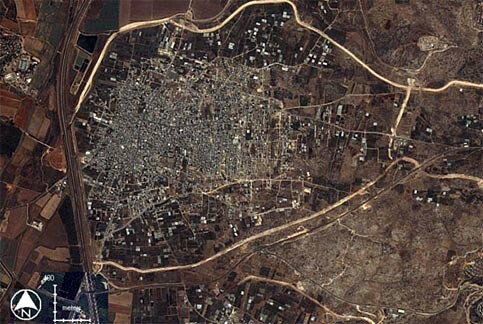The Association for Civil Rights in Israel 31 August 2004

The Wall around Qalqiliya, where it imprisons 100,000 Palestinians in the city with one Israeli-guarded exit. Hugging the urban area, the Wall separates the city’s residents from the surrounding agricultural land.
The Association for Civil Rights in Israel submitted a petition to the Supreme Court this morning against the Prime Minister, The Minister of Defense, the Israel Defense Forces (IDF) commander in the area of Judea and Samaria, and the Separation Barrier Administration, to demand the dismantling of the section of the barrier that was constructed in the Alfei Menashe enclave to the south and east of Qalqilya, and completely surrounds the residents of five villages cutting them off from the rest of the West Bank. This enclave, it states in the petition, imposed an economic and social disaster on the residents of the villages by separating them from their agricultural land, public services required to maintain a normal life, and from all education and health services. As a result of the deteriorating situation in the enclaves ACRI is asking the court to set the soonest possible date for the hearing on the petition. It should be noted that the petition calls on the court, for the first time, to order the dismantling of a section of the separation barrier. The petition was submitted by Attorney Michael Sfard on behalf of ACRI, and in the name of six residents that live in two of the villages in the enclave, Ras Tira and Wadi A-Rasha.
The more than 1000 Palestinian residents that live in the Alfei Menashe enclave have found themselves trapped on all sides by a barrier that has rendered almost all aspects of daily life impossible, separated the residents from their pasture and agricultural land that provided them with a livelihood, torn them apart from their extended families, and created a situation of unbearable social isolation in order to leave the Jewish settlement of Alfei Menashe and its undeveloped municipal land to the west of the barrier. The route of this section of the barrier was a result of political pressure and has nothing whatsoever to do with security considerations. The petitioners were made aware that the route of the barrier in the area came about primarily as a result of pressure by residents of the Jewish residential community of Matan (within Israel’s borders) when a new road was due to be constructed to connect Alfei Menashe with the state of Israel. It was this pressure that brought about the current route of the barrier and the entrapment of the villages in the enclave, and not security considerations, in the name of which this section of the barrier was built.
In addition to being fenced in by an enclave, the residents are also subject to a permit regime imposed by the IDF that has created a situation of conditional residency and made the residents dependent upon Israeli bureaucracy. The residents are required to obtain a permit to reside on their land or in their homes (non- residents are unable to obtain such permits) and are thus condemned to a life of isolation with no way of hosting family or friends, as well as a miserable existence of economic, social, and cultural atrophy. Over the last year, the petition emphasizes, almost all the residents of the enclave lost their source of livelihood as a direct result of the barrier`s route, and their battle for survival is forcing them to choose between two primary sources of income: illegal entry into Israel (there is no partition or barrier between the villages of the enclave and Israel, which, it should be noted, directly contravenes the stated purpose of the barrier) or temporary work for starvation wages in the settlement of Alfei Menashe as menial laborers of the Jewish settlers. Thus the terrible process is complete of indentured servitude of the Palestinians by their lords, the settlers, by creating a criminal reality of institutional and systematic discrimination. If the barrier remains where it is, the petition claims, the villages that were full of life and commerce for dozens, and in some cases hundreds, of years, will be caged in and the residents forced to abandon them and become refugees. The barrier, in its present route, generates a process of “voluntary” population transfer.
The petition describes a wide range of severe infringements on the residents in addition to the loss of livelihood and enforced social isolation which include: humiliation by IDF soldiers, children who are forced to go by foot along the barrier to reach their schools being threatened with weapons, preventing the entry of ambulances into the area of the enclave in emergencies, placing serious difficulties in the way of residents requiring medical attention, which in the past they could have reached within a few minutes, as well as preventing the supply of gas for cooking and religious services.
ACRI makes clear that this terrible reality, which is not a mere prediction of things to come but is the harsh and present reality, requires that the barrier, should the decision be made that it must exist, be dismantled and moved to coincide with the green line. The security of Alfei Menashe in this instance will be ensured by the establishment of a series of barriers around the settlement, and not around the villages (it is noted in the petition that a fence surrounding Alfei Menashe already exists). The miserable lives that have been forced onto the residents of the enclave are a recipe for rage and hatred, and dovetail a reality in which Palestinian residents in search of an income are directed toward criminal activity by the Israeli bureaucracy. This is particularly significant when one considers the fact that there is no obstacle or gate between the villages and Israelis living within Israel. This reality, ACRI states, is inconsistent with the declared purpose of the barrier to provide security for citizens of Israel.
Related Links